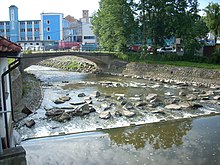Jihlava
Historically, Jihlava is the oldest mining town in the Czech Republic, older than Kutná Hora.
The most common theory has it derived from the German word Igel, meaning 'hedgehog', usually in reference to the city's coat of arms.
The highest point is the hill Popický vrch with an elevation of 682 metres (2,238 ft), located on the southern municipal border.
Jihlava was originally a Slavic market village with a small Church of Saint John the Baptist, established on a trade route around 1200.
The regular plan of the rectangular network of streets with a large square in the middle was given by the building regulations of King Ottokar II from 1270.
[9] In the era of the Hussite Wars, Jihlava remained a Catholic stronghold and managed to resist a number of sieges.
A marble relief near the city marks the spot where Ferdinand I, in 1527, swore fidelity to the Bohemian estates.
[9] In 1742, it fell into the hands of the Prussians, and in December 1805 the Bavarians under Karl Philipp von Wrede were defeated near the city.
The city gates with narrow passages were demolished at the beginning of the 19th century, and the façades of the houses were remodeled in the Neoclassical style.
The city and its surroundings constituted a German-speaking enclave within Czech-speaking Bohemia and Moravia, so-called Jihlava language island.
[12] The relatively peaceful coexistence of the Czech and German-speaking inhabitants that lasted for hundreds of years ended with the nationalism caused by the Sudeten German Party of Konrad Henlein, which raised in 1933.
Most of Jihlava's Jewish population, which numbered over 1,000 people, was deported and killed due to the Holocaust in Bohemia and Moravia.
[13][14] After the end of World War II, starting from 9 May 1945, German-speakers were banned from using public transportation and were ordered to carry white armbands identifying them as Germans.
[10] Between 1950 and 1952, Jihlava was the site of several show trials of Communist Party of Czechoslovakia, which were directed against the influence of the Catholic Church on the rural population.
[16] In 1969, in protest against the normalization in Czechoslovakia, Evžen Plocek set himself on fire on the city square in emulation of others in Prague.
[17] On 6 June 1991, after the collapse of centrally-planned socialist economy, the first ever supermarket in now-capitalist Czechoslovakia opened in Jihlava.
[24] The Jihlava agglomeration was defined as a tool for drawing money from the European Structural and Investment Funds.
The I/38 road (the section from Znojmo to Havlíčkův Brod, part of the European route E59) passes through the city proper.
[25] Intra-city transport is provided by the company Dopravní podnik města Jihlavy a.s., which is owned by the city of Jihlava.
In the mid-16th century, a turret with clock was added, a Gothic hall was established and the façade was decorated by a large Renaissance fresco.
In 1786, the second floor was added, the fresco was overlayed by new façade, and the large Gothic hall was split in half by the wall.
[32] The Church of Saint Ignatius of Loyola on the city square was built in the early Baroque style in 1683–1689 for the Jesuits.








